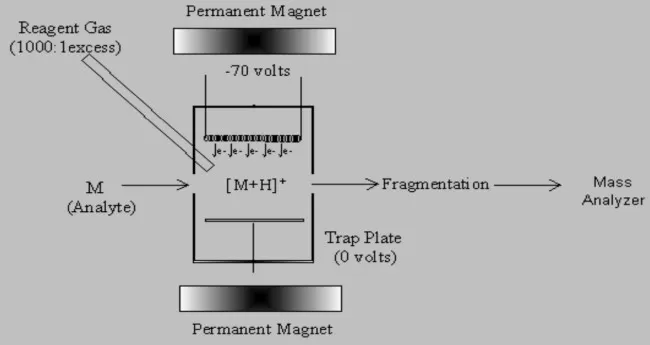Chemical Ionization (CI): Innovations, Applications, and Future Prospects
Chemical Ionization (CI) is a sophisticated and widely utilized mass spectrometry technique characterized by soft ionization, particularly suited for analyzing thermally unstable, highly polar, or low-volatility compounds. Due to its gentle ionization mechanism, CI minimizes fragmentation, preserving molecular information vital for accurate identification. This blog thoroughly discusses the foundational principles, technological advancements, extensive applications, challenges, and future directions of CI, providing valuable insights into its importance and potential in analytical chemistry.
Core Principles and Mechanisms of Chemical Ionization
Chemical ionization achieves analyte ionization through ion-molecule reactions involving a reagent gas, typically methane or ammonia, which undergoes electron bombardment or discharge within the ion source to produce primary reactive ions (e.g., CH₅⁺, NH₄⁺). These ions subsequently interact with analyte molecules through proton transfer, charge exchange, or addition reactions, creating molecular ions (e.g., [M+H]⁺, [M+NH₄]⁺) with minimal fragmentation. Thus, CI offers a controlled ionization environment that facilitates the selective detection of target molecules, crucial for complex sample analysis.

Working principle of CI
Selection and Optimization of CI Reagent Gases
The choice of reagent gas significantly impacts CI performance and specificity. Methane, commonly employed in CI, provides high proton-transfer efficiency, ideal for routine analyses requiring robust molecular ion generation. However, methane's vigorous reactivity may induce undesired fragmentation for certain sensitive analytes. Conversely, ammonia offers increased selectivity, generating fewer fragments but potentially forming multiple adduct ions, complicating spectra interpretation. Understanding these dynamics enables analysts to strategically select and optimize reagent gases tailored to specific analytical needs.
Technical Innovations and Methodological Improvements of Chemical Ionization
Significant technological innovations have expanded the versatility and analytical capability of CI sources. Chemical derivatization is one key approach, introducing charged or hydrophobic functionalities to enhance analyte ionization, particularly beneficial in lipid analysis via gas chromatography (GC). Methods such as esterification or silylation drastically improve detection sensitivity, rendering CI applicable to a broader range of analytes.
Recent advancements also include miniaturized and specialized CI techniques, such as Microfluidic Flow Probes (MFP), enabling high-resolution mass spectrometry imaging (MSI) of biological samples. This advancement facilitates the visualization of molecular distributions within tissue samples at micron-level spatial resolution, revolutionizing biological research fields.
CI has notably benefited from integration with high-resolution mass spectrometry (HRMS) and ion mobility spectrometry (IMS), significantly improving its analytical power. The combination of these technologies allows researchers to distinguish between isomeric compounds and to obtain detailed structural insights. Moreover, innovative applications such as electrospray ionization coupled with photoelectron circular dichroism (ESI-PECD) have enabled precise measurements of enantiomeric excess, expanding CI’s applicability into stereochemical studies.
Comparative Analysis of CI with Other Ionization Techniques
Compared to other ionization methods like electron ionization (EI) and electrospray ionization (ESI), CI offers distinct advantages and limitations. CI’s "soft ionization" nature significantly reduces fragmentation, which is highly beneficial for analyzing thermally unstable or highly polar molecules. Unlike EI, which generates extensive fragmentation patterns useful for structural elucidation but potentially challenging for complex mixtures, CI simplifies mass spectra by producing fewer fragment ions. Conversely, while ESI is highly efficient for polar molecules in liquid-phase analyses, CI uniquely suits gas-phase analysis of less volatile, moderately polar substances, making it particularly valuable for diverse analytical scenarios.
Broad Applications of CI Technology
The versatility of CI has made it a cornerstone technique across various analytical fields. In environmental science, CI-MS has become essential for tracing pollutants in air, water, and biological matrices, effectively detecting minute quantities of contaminants such as organic pollutants and pharmaceutical residues. FIGAERO-CIMS, for instance, provides detailed analyses of atmospheric aerosols, yielding insights into atmospheric chemistry and air quality.
In health sciences, CI is pivotal for precise biomolecule detection. For example, it is extensively utilized in lipidomics and metabolomics, effectively differentiating lipid isomers and pinpointing double bond positions in complex lipid structures, facilitating disease diagnosis and biomarker discovery. Furthermore, CI-based methods contribute to Alzheimer's research by enhancing protein analysis and biomarker discovery, significantly impacting early diagnosis and understanding of pathological mechanisms.
Additionally, chemical ionization plays a crucial role in material sciences, particularly in nanotechnology. It aids in deciphering reaction pathways involved in nanostructure formation by precisely identifying reaction intermediates, thus improving the understanding and optimization of fabrication processes.
Challenges, Innovations, and the Future of CI
While CI technology has demonstrated extensive applications and success, it faces several challenges, including ion suppression caused by complex matrices and salts, which can adversely affect sensitivity and reproducibility. Researchers have responded by developing advanced methods such as solvent-assisted thermal desorption and microfluidic platforms to mitigate these issues. Additionally, the integration of machine learning and artificial intelligence promises significant future improvements, enabling predictive modeling of ionization efficiencies and more precise optimization of analytical conditions.
Looking forward, continued innovation in CI technology—especially its combination with cutting-edge approaches like microfluidics, automation, and intelligent optimization systems—will likely expand its analytical potential further. The pursuit of miniaturization and portability for field-based applications is particularly promising, potentially revolutionizing environmental monitoring, clinical diagnostics, and forensic science.
Read more
- LC-MS VS GC-MS: What's the Difference
- LC vs. HPLC vs. UHPLC: Tracing the Evolution of Chromatographic Techniques
- Mastering Chromatography: Everything You Need to Know
- DIA Proteomics vs DDA Proteomics: A Comprehensive Comparison
- Multi-Omics Association Analysis Series
- Omics Data Processing Series
- Omics Data Analysis Series


